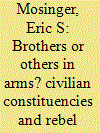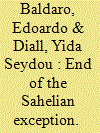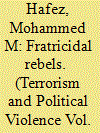| Srl | Item |
| 1 |
ID:
157584


|
|
|
|
|
| Summary/Abstract |
Why do united rebel fronts emerge in some insurgencies, while in other insurgencies multiple rebel groups mobilize independently to challenge the state, and often, each other? I develop a diffusion model of rebel fragmentation in which participation in rebellion spreads, completely or incompletely, through networks of civilians and dissidents. Using this theoretical framework I hypothesize that two factors jointly determine whether a rebel movement remains unified or fragments: the rebels’ investment in civilian mobilization, and the overall level of civilian grievances. The theory predicts that widely shared grievances motivate the formation of many small dissident groups willing to challenge the regime. Given the difficulty of collective action between disparate opposition actors, an emerging rebel movement will tend towards fragmentation when popular grievances are high. Yet extremely high civilian grievances can also help rebels activate broad, overlapping civilian social networks that serve to bridge together dissident groups. Mass-mobilizing rebel groups, benefiting from the participation of broad civilian networks, are most likely to forge and maintain a unified rebel front. I test this theory alongside several alternatives drawn from cross-national studies of conflict using regression analysis. The quantitative evidence lends considerable credence to the role of rebel constituencies in preventing or fomenting rebel fragmentation.
|
|
|
|
|
|
|
|
|
|
|
|
|
|
|
|
| 2 |
ID:
178525


|
|
|
|
|
| Summary/Abstract |
Until the beginning of 2020, the Sahel was something of an exception with respect to international rivalry between jihadists. This came to an end when violent clashes involving supporters of Al-Qaeda and those affiliated with the Islamic State were recorded in central Mali. The violent escalation that has taken place between Katiba Macina and Islamic State in the Greater Sahara in the inner Niger Delta should be framed as a battle between a dominant power whose position has begun to be contested, and a rising challenger trying to exploit the situation. More specifically, the rise of Islamic State appears directly connected to the material and symbolic crisis of the system of governance established by Katiba Macina in the area under its control. As the result of a process that cuts across various developments in the recent history of Mali, the conflict between the two jihadist movements threatens to unlock a new and more violent phase in Mali’s longstanding crisis.
|
|
|
|
|
|
|
|
|
|
|
|
|
|
|
|
| 3 |
ID:
172193


|
|
|
|
|
| Summary/Abstract |
Why do rebels kill each other? When confronting a formidable regime, rebels often descend into warring factionalism rather than forge unity across their ranks to reap the advantages of cooperation. This article tackles the puzzle of inter-rebel fratricide. It explores power and resource competition arguments, and contrasts them with ideological mechanisms that can drive inter-rebel violence. It argues that ideological extremity is central to rebel fratricide. Rebel organizations with common ideological origins can still compete with each other based on their degree of centrism and extremism, making them ideologically distant. This proximity-distance paradox makes their cohabitation mutually threatening. Ideological challengers from the same family tree are particularly threatening to one’s group cohesion, and if successful, guarantee one’s political marginalization within the broader movement. Extremist groups are likely to respond to these threats with fratricide, while ideologically centrist ones will rely on other strategies such as balancing, outbidding, or defecting to manage their rivalries. Algeria’s civil war, 1992–2002, is a plausibility probe case study that illustrates these causal mechanisms. The study contributes to a burgeoning literature on the role of ideology in armed civil conflicts.
|
|
|
|
|
|
|
|
|
|
|
|
|
|
|
|